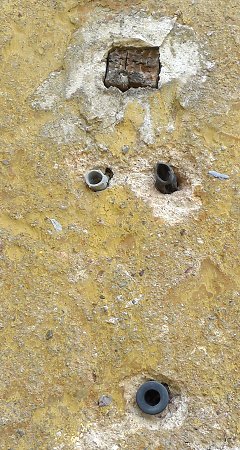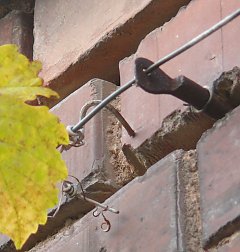Wall Fixings (Rawl Plugs/Dowels/Anchors) from FassadenGrün
All pre-assembled kits include rawl plugs (wall anchors) which may be inserted into common building materials such as concrete or masonry. Special cases are dealt with in 'Wall Types.' Here, in this section, you will learn why specific anchors were chosen and what special solutions there are. If you do not need anchors/plugs in your kit -- e.g. for mounting in solid wood -- please write us a note at checkout; your invoice amount will be reduced accordingly. >>> Price list
Historic Wall Anchor Techniques
The forerunners of today's plugs and anchors were soft, tubular parts, and are just a century old. In even earlier times, trellises made of wood or wire were anchored in 2 ways: either massive iron anchors were cemented into the wall or conical (tapered) larger, more rear-ward holes were made in the wall, into which a similarly shaped piece of hardwood was then cemented or plastered as an 'anchor/plug.' Screws, grommets, or nails could then be attached.
Specifications for Wall Plugs with Climbing Aids
Holders (brackets) for tensioned wire ropes are particularly subject to bending, less than being pulled out. Our anchor assortment takes this into account: long anchors (wall/rawl plugs) with a collar are generally preferred; these allow a deep anchoring and provide a guide against bending at the front. In addition to structural requirements, it is also a question of the drill hole closure, especially with plastered walls. Again, an anchor (wall plug) with front reinforcement or 'collar' has an advantage because it guides the projecting threaded shank better and thereby prevents load-induced movements and spalling of the plaster.
Easy and 'Eco' Kits: All-Purpose Fixings (Collar Anchors)
From the large number of commercially available plastic anchors (rawl plugs), especially 'garden shed anchors'- the DH 10065 has proven particularly effective with our Easy Kits. The strong collar (with its powerful bonding) prevents the anchor from dropping deeper during during assembly, guides and holds the eyelets screwed in (even under heavy loads), and closes the hole nicely. Due to its rectangular geometry and the rows of 'claws,' insertion has good initial tack/grip; that is, the anchor will not twist while screwing in. It is also available in different sizes for special cases.
Light and Premium Kits: Spiral Plugs
"Spiral plugs" are anchors used in our Light Kits and Medium 'Premium' Kits, but are not separately available in our product line. Their soft material allows metric threads to be screwed in.
Medium Classic Kits: Parallel Expansion Fixing (Anchor)
Anchors for Medium 'Classic' Kits are mounted against the wall to insure support, thereby increasing flexural strength (resistance to bending). This pre-tension results in high tensile forces, which require secure and deep anchoring. For this the anchor DL 12090 was designed-- the unusually long anchor (rawl plug/dowel) technology enables the construction of high anchoring forces over the entire length of the anchor.
Heavy Kits: Composite Mortar
The 'cementing in' of holders with composite mortar VM 00300 is an inexpensive alternative and is used with Heavy Kits. Special winter mortar is available for the winter. For hollow masonry, the composite mortar anchor sleeves (sieve sleeves) SD 16130 are needed, in addition to the composite mortar.
Important: cemented bonds are 'non-detachable connections.' If you wish to remove them from the wall, they must be 'chiseled,' sawn off (using an angle grinder, for example), or cut off.
Massive Kits: Heavy-duty Anchor
These patented anchors for Massive Kits are not sold separately, but are already mounted on the rope mounts/spacers. With them, the mounts are very easy to install, and unlike a bonding with composite mortar, the anchor can be loosened again if necessary.
Concrete Garages and Granite: Brass Plugs
For thin concrete walls (like in concrete garages) and for some special cases, such as eyebolts in granite, brass plugs DM 10030 in various sizes can be used.
Panel Building Materials: Hollow Wall Anchors
Hollow wall ('cavity') anchors HD 06050 and HD 08050 are sometimes used for tricky installments in wall cladding (shuttering) and panelling, allowing Light or Medium Premium Kits to be used, whereas other hollow wall anchors, such asDK 08050, then disappear from the assortment.
Other Special Anchors
For direct mounting in insulation, DD 00085 is recommended; short sieve sleeves are sometimes required for special cases. More special plugs/fixings-- like the toggle bolt KD 10080 and the insert fitting ED 01060--have hardly any relation to our holder assortment, but continue to be offered for our regular customers.
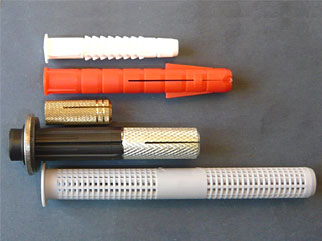
From top to bottom: collar anchors DK 10065, long fixings DL 12090, brass plug DM 10030, Heavy-duty anchor for WM 12153 and perforated sleeve SD 16130
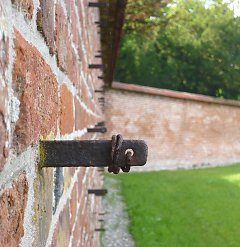
Historic rawl plug (anchor/dubel) technique: Cemented flat iron holder, climbing wires for espalier fruit in an old kitchen garden
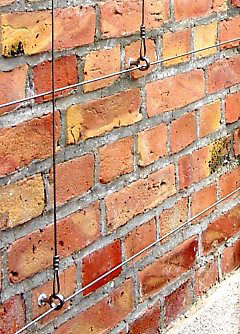
DK 10065 creates a good borehole closure

